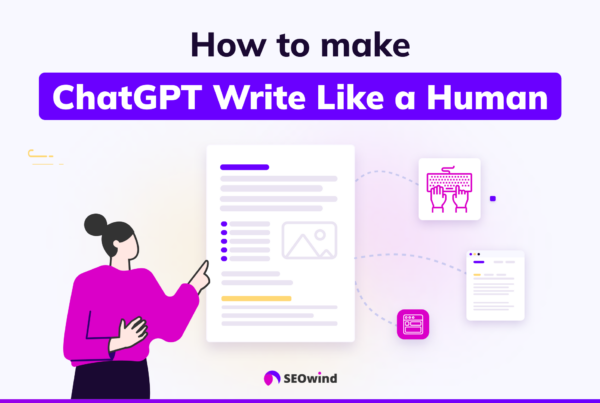The question “How long does it take to write a blog post?” is frequently asked by beginner and experienced content creators. Although there is no one-size-fits-all answer, understanding key factors that impact writing time and mastering several tips to scale up productivity can significantly improve your blogging endeavors. In this comprehensive article, we will dive into those aspects and harness the power of artificial intelligence and SEO tools to optimize your process and create quality content more efficiently.
What is a Blog Post?
A blog post is an integral component of digital content marketing, traditionally housed in a website’s dedicated blog section or used as guest posts on other websites for outreach purposes. These engaging pieces serve as valuable resources for readers, boosting traffic, establishing authority within a niche, and nurturing relationships with clients or potential customers.
Characterized by their informative nature, they convey the author’s knowledge or perspectives on various topics that interest the target audience. Whether you want to share personal stories or provide professional insights, creating qualitative and well-crafted blog posts is essential in today’s competitive online environment.
Here are some common elements that make up a good blog post:
- Engaging blog headings: Grabs the reader’s attention.
- Introduction: Provides context or sets up expectations.
- Subheadings: Divide the content into digestible sections for easy navigation.
- Body paragraphs: Elaborate on key points related to the topic.
- Internal links: Connects relevant articles or external sources for additional insights.
- Media elements: Images or videos to create visual appeal and enhance comprehension.
- Conclusion: Wraps up the discussion with actionable advice, enticing readers for further interaction.
Understanding what constitutes a great blog post lays the foundation for exploring how long it takes to produce such captivating content while optimizing our writing efficiency with proven techniques and tools discussed later in this article.
How Long Does it Take the Average Person to Write a Typical Blog Post?

The time it takes for an average person to write a blog post can vary significantly, depending on several factors. While there is no universal answer, we can consider some general estimates based on research and experience.
Typically, the writing process for a blog post comprises researching, outlining, drafting, editing, formatting, and optimizing. For an average writer with blogging experience, this process may take around 3-5 hours for a well-researched 1,000-word article that includes images and proper SEO optimization. However, these numbers differ depending on topic complexity and individual skills.
Here is a rough breakdown of how much time each phase of writing might consume:
- Research: 30 minutes – 2 hours
- Outlining: 15 – 45 minutes
- Drafting: 1 – 4 hours (depending on word count)
- Editing: 30 minutes – 1 hour
- Adding images & formatting: 15 – 45 minutes
- Optimizing for SEO: 15 – 45 minutes
If we consider other variations like longer articles (e.g., how long does it take to write a blog post of about 2k words), the average time required may increase proportionately or even more depending on-depth coverage needed.
Beginners who have limited experience in writing blogs or are just starting their content journey online should anticipate allocating additional time for learning and experimentation.
Though it’s important to acknowledge that every writer works at their own pace, disparities in workflow are inevitable when addressing questions like “How long does it take to write an article?”. Nonetheless, through practice and the application of practical techniques tailored to your unique strengths and weaknesses as a blogger or content creator, you can optimize your speed and quality.
Statistics on How Long It Takes to Write a Blog Post
It takes an average of four hours and 10 minutes to write a blog post in 2022. 36% of bloggers who spend more than 6 hours on writing a post report “strong results.” (Orbit Media, 2022)
Factors Affecting the Time it Takes to Write a Blog Post
The time it takes to write an engaging and informative blog post may vary depending on several factors. Understanding these aspects can give you a better idea of how long you should allocate when planning your content creation process. The following sections discuss some essential factors that influence the average length of time it takes to write a blog post.
Length of the Blog Post
Naturally, one of the most significant factors affecting how long it takes to write a blog post is its length. For instance, writing a 500-word article takes less time than composing a 2000-word piece. However, this also depends on other variables, such as the topic’s complexity and the research required.
Research Required
Another contributing factor to how long it takes to write an engaging blog post is the amount of research needed for each topic. Detailed articles will likely need more background information, statistics, or expert opinions from various sources. On the other hand, writing about well-known subjects or your personal experiences may require less in-depth research, thereby reducing writing time.
Scope of Coverage
The scope of coverage can also impact how long it takes to write an article. Deciding whether an essay should be comprehensive – covering multiple subtopics or points – or focused on a specific aspect will play a role in determining the amount of research needed and writing involved in creating quality content. Consequently, wider-scope articles may take considerably longer than narrowly-focused pieces.
The Complexity of the Topic
In addition to the scope and length factors mentioned previously, discussing complex topics can dramatically add to extra hours in drafting your blog post. Striking a balance between technical accuracy and easier readability requires extensive knowledge about your subject matter and an exceptional language skillset working symbiotically together. Tailoring complex information for beginners’ absorption inevitably multiplies researching and processing times.
Media Creation
Content success often depends on media inclusion, such as relevant images, infographics, or videos to enhance the blog post’s aesthetic and value. Crafting high-quality photos, diagrams, or visual aids that perfectly correspond with your written content can be time-consuming. Remember to account for how long media creation takes when estimating how long it will take you to complete a blog post.
A thorough understanding of these critical factors plays an essential role in crafting engaging and informative articles while streamlining your content production process. By considering factors like the average word count, research needs, the scope of coverage, topic complexity, and appropriate media assets incorporation, you’ll better grasp the time it takes to create captivating blog posts consistently.
How to Write a Blog Post Quickly


Writing a high-quality blog post takes time and limited resources, but with the right approach and techniques, you can speed up the process and write content without compromising quality. This section review seven steps to help you write an engaging blog post efficiently.
Brainstorming & Research
- Jot down any ideas that come to mind.
- Validate your ideas by conducting keyword research.
- Investigate other sources like competitors’ blogs or industry-related forums for inspiration.
- Collect information from reputable resources to support your points.
A well-researched blog post will likely engage more readers, and improve its search visibility. Therefore, it’s essential to dedicate sufficient time to brainstorming and research.
SEO Strategizing
- Focus on one primary keyword throughout the article (e.g., “How long does it take to write a blog post”).
- Find related keywords clustered by similarity (e.g., “How long should it take to write a blog post”).
- 3-5 relevant keyword phrases per section. Make sure they sound natural when used.
By incorporating SEO best practices into your content creation process, you enhance the chances of driving organic traffic from search engines to your website while maintaining an enjoyable reading experience for the user.
Blog Post Outline
Creating an outline before diving into writing ensures all key points are covered while preventing redundant information or disorganized thoughts within the article.
- Begin with an introductory paragraph explaining the main topic.
- Add subheadings to segment different aspects of the topic logically.
- With each section, aim to expand upon—rather than repeat—the existing content.
Writing the First Draft
Keep sentences short and easy to read through:
- Maximum 15-word sentence limit.
- Use active voice predominantly
- Add logical transitional phrases, e.g.,” Between acquiring knowledge and expressing it,_.”
- Make ideas conversational yet professional.
- Aim for a readability score of grade level 9 or below (check Hemingway Editor).
Adhering to these guidelines makes your content readable and engaging to the target audience.
Editing and Proofreading
Editing and proofreading enable you to improve upon the initial draft by ensuring grammatical accuracy and coherence, ultimately delivering a polished and well-rounded article.
- Focus on eliminating repetition, redundancies, or filler words.
- Verify proper Tenses & Forms in verbs usage
- Validate clarity in article structure.
Creating Images and Formatting
An attractive layout with visual enhancements increases reader comprehension and overall engagement. After all, blog content should be as enjoyable to look at as it is to read.
- Add relevant images to support your points or break up long sections.
- Format headers/subheaders systematically.
- Utilize bullet points/ordered lists when appropriate.
Grammar and Plagiarism Check
Before publishing a single post, double-check grammar and plagiarism. It safeguards your reputation and ensures the credibility of the information provided to readers.
- Use grammar-checking tools like Grammarly.
- Verify originality through plagiarism checkers such as Copyscape or Turnitin.
By following this framework in writing blog posts quickly without compromising quality, you can efficiently produce high-performing articles while maintaining a reliable content schedule – giving you and your audience something valuable each time they visit your website!
Tips to Write Blog Posts Faster


Efficiency is key. The faster you can produce great blog posts, the better your results will be. In this section, I’ll share some useful tips on creating more blog posts, more quickly without compromising quality.
Create Templates for Different Content Types
One way to speed up the writing process is by creating templates for different types of content. This can help streamline your workflow and save time when starting a new post. Some standard templates might include the following:
- Listicles
- How-to guides
- Product reviews
- Interviews or expert roundups
- Case studies
For each type of content, develop a standard format with headings and subheadings that allow you to fill in the information quickly while maintaining a consistent structure.
Learn From Your Competitors
Analyzing what works for your competitors can help inform your content strategy and inspire new ideas. Explore their most popular posts, note their formatting and headline style, and observe what engages their audience. By incorporating successful tactics from other blogs into your work, you may achieve similar results more efficiently.
Write Drunk, Edit Sober
Many renowned writers have written positively about adopting Hemingway’s famous advice: “Write drunk; edit sober.” The idea behind this approach is to unleash creativity during the drafting phase by silencing inner critics, which often hinder progress. Remember that it’s not about being intoxicated. It’s more about allowing yourself to write freely and passionately before returning later with a fresh perspective to refine and polish your work.
Have a Clear Objective for Every Article
Before beginning the first page of any article, establish its purpose – educating readers about a particular topic, promoting a product or service, or offering actionable tips based on personal experiences. Having clear objectives ensures that every paragraph contributes towards a cohesive message which helps maintain focus throughout the writing.
Create an Outline of Your Article
Outlining your article before you start writing can save you significant time. A content outline serves as a roadmap for your post, helping to organize thoughts and ensure that the content flows logically from one point to another. Break your article into sections using headings and subheadings, then make bullet points or summaries for each subsection.
Get Rid of All the Distractions and Follow a Schedule
Distractions can hinder the progress of even the most experienced writers. To maintain focus while working on blog posts, eliminate common distractions like social media notifications, emails, or phone calls. Designating specific hours for writing each day or following techniques like the Pomodoro Technique can help improve productivity by limiting procrastination.
Write Regularly
Finally, practice makes perfect. Writing regularly helps sharpen skills and increase familiarity with personal strengths and weaknesses within the craft. The more one writes, the faster it becomes second nature, ultimately improving efficiency when producing high-quality individual blog posts and content.
Remember that how long it takes to write a blog post varies depending on factors like length, complexity, and how much research is required. By employing these tips for writing blog posts faster, you’ll streamline your workflow and produce quality content more efficiently and quickly!
Quality vs. Quantity
When it comes to producing content, the debate between quality and quantity is a common one. Striking the right balance between producing high-quality blog posts and maintaining a consistent posting schedule will significantly influence your success in attracting readers and search ranking. The key is to understand that quality and quantity contribute to the effectiveness of your blogging strategy.
Importance of Quality Content
High-quality content provides value to readers by addressing their needs, answering their questions, or relieving their pain points. It’s essential to build brand credibility, establish yourself as an industry authority, and keep your audience engaged on your platform.
Some benefits of creating quality blog posts include the following:
- Retaining reader interest: Engaging content keeps readers coming back for more.
- Better search engine rankings: Quality posts are more likely to rank higher on Google due to being deemed valuable resources.
- Increased social media shares: Compelling content will likely be shared on social platforms, resulting in greater reach and visibility for your brand.
- Improved conversion rates: By providing meaningful information that resonates with readers, you establish trust leading to better conversions from potential customers.
Significance of Posting Frequency
While emphasizing quality is crucial in attracting readership and generating favorable results, maintaining a regular posting schedule enhances these benefits significantly:
- Constant engagement with your audience keeps them connected with your brand.
- Regular publishing of blog posts signals search engines that your site is active, enhancing its discoverability.
- Scheduled postings train readers when they can expect new material from you; consistency boosts anticipation.
Considering these aspects, we need to find an optimal strategy balancing post quality and frequency.
Striking the Right Balance
To maximize the impact of blogging efforts while combining both elements efficiently:
- Establish realistic goals for post frequency based on available resources (time & budget) without compromising overall quality.
- Begin by prioritizing well-researched, well-written content and consistently monitor engagement metrics (shares, comments, bounce rates) to evaluate its success.
- Examine industry trends and your competitors’ performance regarding the frequency and quality of their blog posts.
- Use data analysis tools to identify which posting schedules work best for your target audience.
- Make adjustments based on feedback and observations as you gain more experience.
Remember that quality should never be sacrificed solely to achieve higher post frequencies. This may backfire by turning readers away. At the same time, infrequent posting might make it challenging for readers to sustain interest in your brand. Finding an equilibrium between quality and quantity ensures sustainable growth while maintaining reader satisfaction.
How Long Does it Take to Write an Average Blog Post with AI?


Artificial Intelligence (AI) technology has been making its way into content creation and blogging, thus raising the question: how long does it take to write a blog post utilizing AI? The answer can vary depending on the tools and software, subject matter expertise, and individual workflow. However, there’s no denying that AI can significantly reduce the time spent on the actual writing of a blog post.
Some primary factors impacting AI-powered writing time include:
- AI Tool Selection: Many AI-driven content generation tools are available today. Choosing an effective one that aligns with your writing goals and style is crucial for faster results.
- Subject Matter Expertise: Even though AI assists with generating text, human input is still required to ensure that the content is relevant, coherent, and engaging. A firm grasp of the topic will speed up this process considerably.
- Individual Workflow: An essential aspect of working with AI tools is integrating them seamlessly into your existing workflow. Streamlining communication between you and the tool ensures efficiency throughout the writing process.
Advantages of Writing Blog Posts with AI
With these factors in mind, let’s take a look at some advantages of incorporating AI into your writing routine:
- Generate Content Faster: Utilizing AI algorithms can result in quicker research and drafting stages by automatically generating short pieces or even full-length articles within seconds.
- Improve Efficiency: By handling repetitive tasks like keyword and content optimization or sentence rephrasing, AI allows you to focus more on creativity and higher-level strategy.
- Keep Tone and Style Consistent: Advanced natural language processing (NLP) techniques often enable consistency in maintaining your desired voice throughout multiple pieces of content.
- Leverage Prompts for Inspiration: For writers experiencing writer’s block, many modern-day AI platforms offer tailored suggestions and ideas to kick-start your creativity.
While AI technology can be incredibly helpful in cutting down the time it takes to write, revise, and optimize a blog post, it’s still not entirely autonomous. Combining the strengths of human expertise with AI-driven technology can lead to more efficient writing sessions and consistently high-quality content.
Combining the benefits of both human experience and advanced algorithms may significantly reduce the time spent writing while ensuring robust and engaging content authentic to your target audience.
How Long Does It Take to Write a Blog Post with SEOwind?
SEOwind is an advanced content optimization and analysis tool designed to streamline the process of creating high-quality, search-engine-optimized blog posts. Reducing the time spent on research, content planning, and providing in-depth keyword suggestions can significantly reduce the duration needed to write a well-optimized blog post.
You can write AI Blog Post with more than 2000 words within 30 minutes, including research. Exciting, right?
To understand how long it takes to write a blog post using SEOwind effectively, let’s break down the steps involved:
Content Analysis, Keyword & Topic Research & Content Outline
SEOwind is a SERP and SEO Content Analyzer. It analysis top-performing content and collects all the data needed for crafting unique content:
- Competitive Analysis with organic keywords top SERPs are ranking for
- Competitor Outlines
- Questions to Answer
- Content recommendations on content length, number of headings, and images
- Secondary keywords clustered semantically
Content Outline and Optimization Suggestions
SEOwind AI allows you to create a comprehensive outline based on SEO and SERP data with one 1-click. It also helps you with writing titles and descriptions.
This step allows you to create comprehensive outlines for your blog posts within just 15 minutes instead of spending several hours gathering data manually.
AI Blog Post Writing
Once you have the outline ready, you can generate a blog post with AI. It usually takes up to 15 minutes to have it ready. From our experience those articles and long-form content with 2000 words and more.
Proofreading and editing
You need to make this step on your own. This is the part where you put an additional value on top and take care of the tone of voice, language, and branding.
FAQs on Writing a Blog Post
How long does it take to write a 1,000-word blog post?
Determining how long it takes to write a 1,000-word blog post can vary depending on several factors, such as the writer’s experience, research requirements, and the complexity of the topic. On average, it may take an experienced writer about one to three hours to complete a well-researched and articulate 1,000-word blog post. For beginners or less-experienced individuals, this process could take up to four or five hours.
It’s important to note that these estimates do not account for additional time needed for tasks like brainstorming ideas or creating accompanying visual content. To improve your writing speed:
- Conduct thorough research before starting
- Create an outline to guide your writing
- Minimize distractions and stay focused on the task at hand.
💡 With AI tools like SEOwind, writing a 1,000-word blog post can take up to 20 minutes.
How long does it take to write a 500-word blog post?
Writing a 500-word blog post typically takes less time than writing a lengthy one. Still, it is subject to similar variables, such as research needs and writing expertise. An experienced freelance writer often can complete a quality 500-word article in under an hour if minimal research is required. However, if extensive investigation is necessary, the time spent could increase accordingly.
Completing a well-constructed 500-word piece may take two or even three hours for those new to content writing or tackling intricate subjects. Tips for increasing efficiency include:
- Streamlining your research process by bookmarking reliable sources
- Utilizing templates for different content types
- Practicing regularly to develop and hone your skills
💡 With AI tools like SEOwind, writing a 1,000-word blog post can take up to 20 minutes.
How long does it take to write a 700-word blog post?
Estimating the time required for crafting a high-quality 700-word blog post depends upon various factors, such as existing knowledge of the subject matter and overall skill level in writing. A seasoned author with ample experience might only require around 90 minutes to create a brief and engaging article.
On the other hand, a less proficient writer or someone exploring an unfamiliar topic may need up to three or four hours to develop their thoughts and construct a polished piece fully. To expedite the writing process:
- Engage in thoughtful planning before beginning
- Set clear objectives for each article’s purpose
- Follow an outline to maintain the structure
💡 With AI tools like SEOwind, writing a 1,000-word blog post can take up to 20 minutes.


